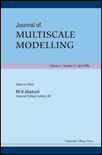
Journal of Multiscale Modelling
Scope & Guideline
Advancing Knowledge Through Innovative Simulation Techniques
Introduction
Aims and Scopes
- Multiscale Modeling Techniques:
Focuses on developing and applying modeling techniques that span multiple scales, including atomistic, mesoscopic, and continuum levels to understand complex material behaviors. - Thermal and Mechanical Analysis:
Covers research on thermal and mechanical interactions in materials, including thermoelasticity, heat transport, and mechanical stress analysis under various loading conditions. - Composite Materials Research:
Explores the behavior and performance of composite materials, including fiber-reinforced polymers and novel composites, emphasizing their mechanical properties and applications in engineering. - Innovative Applications of Materials:
Investigates cutting-edge applications of materials in various fields such as automotive, aerospace, and biomedical engineering, including design and optimization of new materials. - Fatigue and Fracture Mechanics:
Studies the fatigue behavior and fracture mechanisms in materials, particularly under cyclic loading and impact conditions, to enhance material durability and performance. - Numerical Methods and Simulations:
Utilizes advanced numerical methods, including finite element analysis and computational fluid dynamics, to model complex physical phenomena in materials research.
Trending and Emerging
- Nanostructured Materials and Their Applications:
There is a growing emphasis on the behavior and modeling of nanostructured materials, highlighting their unique properties and potential applications in various fields, including electronics and energy. - Hybrid and Composite Materials:
Research on hybrid and composite materials is trending, particularly regarding their mechanical performance and optimization for specific applications, such as in automotive and aerospace industries. - Advanced Computational Techniques:
Emerging computational techniques, including machine learning and AI-driven modeling, are gaining traction, enhancing predictive capabilities and efficiency in materials research. - Health and Safety Applications:
The application of multiscale modeling in health and safety, including the modeling of ventilation systems for pandemic responses, underscores the journal's commitment to addressing contemporary global challenges. - Sustainability and Green Materials:
There is an increasing interest in sustainable materials and processes, with research focusing on environmentally friendly materials and their performance, aligning with global sustainability goals.
Declining or Waning
- Classical Homogenization Techniques:
Traditional homogenization methods have become less frequent in recent publications, as researchers are increasingly looking towards more advanced multiscale approaches that incorporate stochastic and dynamic effects. - Static Analysis of Materials:
Research focusing solely on static analysis without considering dynamic interactions or environmental factors has diminished, indicating a shift towards more comprehensive models that account for real-world conditions. - Basic Material Characterization Studies:
Basic studies on material characterization without a multiscale or application-oriented focus are less common, as the journal emphasizes the integration of characterization with modeling and practical applications. - Simplistic Models in Fluid Dynamics:
Simplistic fluid dynamics models have seen reduced publication frequency, with a growing preference for complex, coupled models that reflect the intricacies of modern engineering challenges.
Similar Journals

STRENGTH OF MATERIALS
Unveiling the secrets of materials under stress.STRENGTH OF MATERIALS is a prestigious journal published by SPRINGER that focuses on the critical field of mechanics of materials, providing an authoritative platform for the dissemination of research and developments in material strength analysis since 1969. With an ISSN of 0039-2316 and an E-ISSN of 1573-9325, this journal serves a global audience of researchers, professionals, and students, contributing essential insights into the physical properties and performance characteristics of various materials under stress and strain. As part of the United States' academic literature, it showcases work that not only advances theoretical knowledge but also applies to practical engineering scenarios. Although ranked in the Q4 tier with respect to its category in Mechanics of Materials, with a Scopus rank of #319 out of 398 (19th percentile), it remains an important resource for those looking to expand their understanding in this specialized area. Researchers can access a wealth of information through this journal, fostering continued innovation and interdisciplinary collaboration.

Materials Physics and Mechanics
Bridging Physics and Engineering for Material AdvancementMaterials Physics and Mechanics is a pivotal journal dedicated to advancing the fields of condensed matter physics, materials science, mechanical engineering, and the mechanics of materials. Published by the Institute of Problems in Mechanical Engineering, Russian Academy of Sciences, this journal has established itself as a valuable resource since its inception, particularly from 2003 to 2004 and now continuously from 2009 to 2024. Although it currently holds a Q4 categorization in various disciplines, its contributions are critical to understanding and developing new materials and their applications in engineering. The journal provides insightful articles that explore the nuances of material properties, their behaviors under different conditions, and the physical principles governing these phenomena. Though it operates under a traditional publication model, the insights provided within its pages are invaluable to researchers, professionals, and students striving to push the boundaries of knowledge in the materials domain. Its ISSN numbers (1605-2730, E-ISSN 1605-8119) serve as a gateway to a wealth of scientific knowledge emanating from the Russian Federation, contributing to the global discourse in materials physics and mechanics.
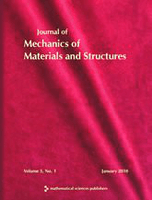
Journal of Mechanics of Materials and Structures
Fostering Academic Excellence in Material Behavior Research.Journal of Mechanics of Materials and Structures, published by Mathematical Science Publishers, is a distinguished periodical in the field of Applied Mathematics and Mechanics of Materials. With the ISSN 1559-3959, this journal has been a pivotal platform since its inception in 2006, providing insights and advancements in the mechanics of materials and their structural applications. Operating out of the University of California, Berkeley, this journal not only boasts a respectable standing within its categories, ranking Q4 in Applied Mathematics and Q3 in Mechanics of Materials as of 2023, but it also serves a crucial role in fostering academic discourse among researchers, practitioners, and students alike. Although it does not currently offer open access, its contributions to the respective fields are invaluable, underscoring the relevance and importance of continued research in understanding material behavior and structural integrity. Whether investigating theoretical frameworks or engineering applications, the Journal of Mechanics of Materials and Structures remains an essential resource for anyone dedicated to the advancement of the science of materials and structures.

International Journal of Mechanics and Materials in Design
Advancing the Frontiers of Mechanics and Material DesignInternational Journal of Mechanics and Materials in Design is a leading publication in the field of mechanical engineering and materials science, published by Springer Heidelberg. With an impressive impact factor, it holds esteemed rankings as Q1 in both Mechanical Engineering and Mechanics of Materials, and Q2 in Materials Science for the year 2023, solidifying its reputation as a significant contributor to the advancement of design methodologies. The journal focuses on the intersection of mechanics and materials, encouraging innovative research that addresses contemporary challenges faced in engineering disciplines. Researchers and professionals alike can benefit from accessing cutting-edge studies contributing to various applications, making it an invaluable resource for staying informed in this dynamic field. While the journal operates under a subscription model, its comprehensive reviews and high-quality original research foster a deeper understanding of material behavior and design principles, thus supporting the academic growth and professional development of its readers.

MATERIALS AND STRUCTURES
Unveiling Breakthroughs in Building TechnologiesMATERIALS AND STRUCTURES, published by SPRINGER, is a prestigious peer-reviewed journal dedicated to advancing the fields of building and construction, civil and structural engineering, and materials science. With an impressive impact factor and a notable Q1 ranking across multiple categories in the 2023 Journal Citation Reports, including Mechanics of Materials, this journal stands as a vital resource for researchers and professionals seeking to disseminate and access high-quality research. Established in 1985, it has continually evolved, showcasing revolutionary research and emerging technologies in material engineering. The journal provides a platform for innovative ideas and methodologies, contributing significantly to the body of knowledge essential for the advancement of sustainable construction practices. Although it does not currently offer Open Access options, the rigorous peer review process ensures the integrity and relevance of its publications, cementing its role as a leading journal in its field. Researchers, industry experts, and students alike will find invaluable insights within its pages, making MATERIALS AND STRUCTURES an essential read for anyone involved in engineering and materials research.
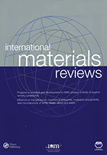
INTERNATIONAL MATERIALS REVIEWS
Unveiling Innovations in Metals and AlloysINTERNATIONAL MATERIALS REVIEWS, published by SAGE Publications Inc, is a leading journal dedicated to the comprehensive analysis of contemporary research in the fields of materials chemistry, mechanical engineering, mechanics of materials, and the study of metals and alloys. With an impressive impact factor and a Q1 ranking across multiple categories such as Materials Chemistry and Mechanical Engineering in 2023, it ranks amongst the top journals for innovative materials research. The journal has a long-standing history since its inception in 1987 and continues to serve as a crucial resource for academics and professionals alike. Although it is not open access, it is renowned for its rigorous peer-review process and its commitment to disseminating high-quality materials science research globally. Researchers, students, and industry professionals benefit greatly from the journal's insightful reviews, both for the advancement of theoretical knowledge and practical applications within the fast-evolving materials field.

Composites Part C: Open Access
Empowering Researchers in Open Access FormatComposites Part C: Open Access, an esteemed journal published by Elsevier, is at the forefront of research in the fields of Ceramics and Composites, Mechanical Engineering, and Mechanics of Materials. Launched in 2020, this fully open-access journal facilitates unparalleled access to significant advancements in composite materials, ensuring that research findings are disseminated widely and freely throughout the global academic community. With an impressive Q1 ranking across multiple related categories and robust placements in Scopus rankings, specifically #78 in Mechanical Engineering and #24 in Materials Science, the journal serves as a vital platform for researchers, professionals, and students to publish their work and engage with cutting-edge studies. It aims to foster innovation and collaboration in the development and application of composite materials and their technologies, making it an indispensable resource for anyone invested in these dynamic fields.
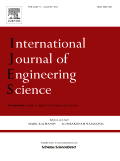
INTERNATIONAL JOURNAL OF ENGINEERING SCIENCE
Advancing the Frontiers of Engineering KnowledgeInternational Journal of Engineering Science, published by Pergamon-Elsevier Science Ltd in the United Kingdom, stands as a premier platform for pioneering research in the diverse fields of engineering and materials science. Since its inception in 1963, this journal has consistently demonstrated its commitment to advancing academic discourse, maintaining an impressive trajectory that positions it in the Q1 category across multiple engineering disciplines including Mechanical Engineering and Mechanics of Materials as of 2023. With notable Scopus rankings—placing it in the top 5% percentile for Mechanical Engineering and related fields—this journal attracts high-quality, impactful research designed for both industry practitioners and academic scholars. Although it does not currently offer Open Access options, its readership is enriched by comprehensive peer-reviewed articles, fostering a deeper understanding of complex engineering problems and innovative solutions. The International Journal of Engineering Science continues to be an invaluable resource for researchers, professionals, and students committed to pushing the boundaries of knowledge in engineering and materials science.
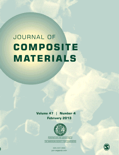
JOURNAL OF COMPOSITE MATERIALS
Connecting Researchers and Professionals in CompositesJOURNAL OF COMPOSITE MATERIALS, published by SAGE PUBLICATIONS LTD, is a premier academic journal dedicated to advancing the field of composite materials. With a long-standing history since 1967, this journal serves as a vital platform for researchers and professionals in the areas of ceramics and composites, materials chemistry, mechanical engineering, and mechanics of materials. The journal's impact is further underscored by its Q2 quartile ranking in various categories as of 2023, alongside notable Scopus rankings in multiple engineering and material science disciplines. Though it currently lacks Open Access options, its rigorous peer-review process ensures the high quality and relevance of its published research. This journal is instrumental in fostering innovation and promoting collaboration among academics and industry professionals, making it essential reading for anyone involved in materials science and engineering.
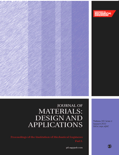
PROCEEDINGS OF THE INSTITUTION OF MECHANICAL ENGINEERS PART L-JOURNAL OF MATERIALS-DESIGN AND APPLICATIONS
Fostering Collaboration in Mechanical Engineering and Materials SciencePROCEEDINGS OF THE INSTITUTION OF MECHANICAL ENGINEERS PART L-JOURNAL OF MATERIALS-DESIGN AND APPLICATIONS is a prestigious academic journal published by SAGE PUBLICATIONS LTD, focusing on the dynamic fields of mechanical engineering and materials science. With an impressive impact factor reflective of its rigorous scholarly contributions, this journal serves as a vital platform for the dissemination of innovative research and practical applications in materials design and engineering processes. Since its inception in 1999 and continuing through 2024, it has maintained a robust reputation, achieving a Q2 ranking in both Materials Science (miscellaneous) and Mechanical Engineering categories, as well as commendable Scopus ranks that place it in the top percentiles of its fields. Located in the United Kingdom, the journal encourages submissions from researchers and professionals who are seeking to advance their understanding of materials applications while fostering interdisciplinary collaboration. Although it currently operates under traditional access terms, the journal prioritizes impactful research that addresses contemporary challenges in design and manufacturing, ensuring that it remains a must-read for anyone invested in the innovations shaping our technological landscape.